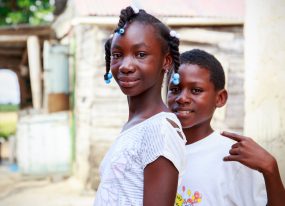Research Brief: Two out of three children in Haiti are victims of physical violence
Background
Physical violence against children is a major global public health problem. Violence against children is pervasive around the world and includes violence by parents and caregivers – often referred to as child abuse or maltreatment – and violence that occurs in communities. The serious nature of the health consequences of physical violence makes it essential to better understand the magnitude of physical violence against children. However, limited data about violence against children is available in Latin America and the Caribbean. Haiti is the poorest nation in the Western Hemisphere and has been affected by political turmoil and social problems. A devastating 7.0 magnitude earthquake in 2010 exacerbated Haiti’s economic, political, and social challenges. More than 1.3 million Haitians were internally displaced, including over 800,000 children. The Haiti Violence Against Children Survey (VACS) was conducted in 2012 to measure the burden of violence against children. This study used the Haiti VACS data to look at the prevalence of physical violence against children by caregivers in the home and public authority figures (such as teachers, police, community leaders). This study also summarized the characteristics of physical violence against children.

Key Findings
- About two thirds of children (67%) experienced physical violence in childhood by an adult caregiver or a public authority figure. The prevalence was not different for boys and girls.
- About one third of 13-17 year-olds (38%) experienced physical violence in the past year; these rates were also similar for boys and girls.
- Victims of physical violence were nearly always punched, kicked, whipped, or beaten with an object (99%); 11% of victims had a perpetrator use a knife or weapon or threaten to use one against them.
- The most common perpetrators of physical violence were mothers (47%) and fathers (40%), followed by aunts and uncles.
- For both boys and girls, when public authority figures were the perpetrators, teachers were the most common.
- Many victims of child physical violence from a caregiver reported significant injuries: 58% had cuts, scratches, bruises, and other minor marks; 14% had sprains, dislocations, and blistering skin; 11% had deep wounds, broken bones, broken teeth, or blackened skin; and 7% had permanent injuries or disfigurement.
What is added by this report?
This study found that physical violence against children in Haiti is common, with an estimated two-thirds of children being victimized before age 18 and one-third of children ages 13-17 experiencing violence in the past year. Violence typically involved punching, kicking, whipping, and beating, but more severe forms of violence were also common. While mothers and fathers were the most common perpetrators, aunts, uncles, and teachers also played a role. This was the first study with a nationally representative sample in Haiti. These data reflect the burden of physical violence against children in the entire country of Haiti, including urban, rural, and camp populations. The results of the VACS have the potential to spur action and policy efforts to address violence against children, support the needs of victims, and make a difference in preventing violence against children on a national level in Haiti.
Flynn-O’Brien KT, Rivara FP, Weiss NS, Lea VA, Marcelin LH, Vertefeuille J, Mercy JA. Prevalence of physical violence against children in Haiti: A national population-based cross-sectional survey. Child Abuse and Neglect 2016; 51: 154-162.
*Footnote: some variation between prevalence estimates from published papers and country reports may exist. This variation reflects slight differences in the subsamples and variables used in the analyses.